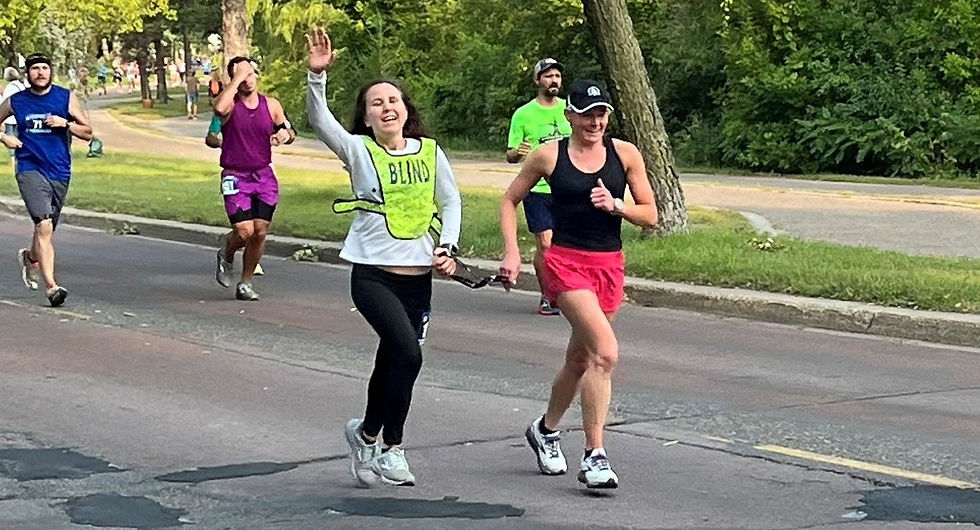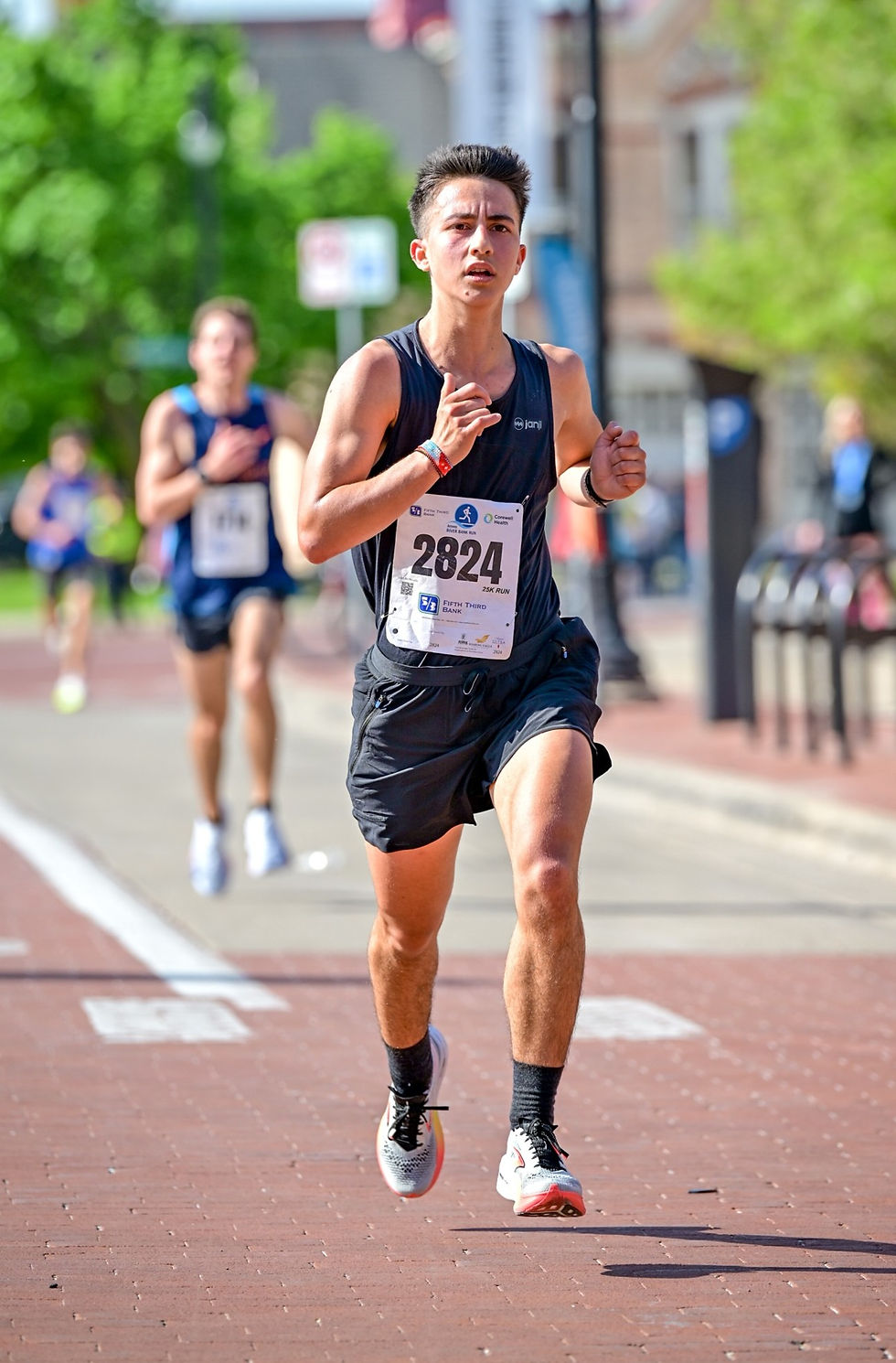Meet Rachel and Her Guide Runner Kelli
- charlie4243
- Aug 5, 2025
- 6 min read
By Sarah Barker
(Just arrived from The Connection? Click here to continue the story where you left off.)

Rachel Hastings’ 2019 Boston Marathon tells a good story, one she laughs about. Now. It explains a lot about running as a blind person, and about the resilience and strength of this blind runner.
“I had this guide, a 3:03 marathoner. We’d been training together. I had been injured, sick—it was a blessing I got to the start. We started and our miles were very consistent. The Newton hills were hard as you expect. Oh yeah, at mile 13 I fell—I bumped into someone who had stopped to take a picture.
“Then at mile 23 the tether breaks. We wrap it around our wrists twice and keep going. At the end of 23 miles, my guide starts slowing down. I’m practically dragging him. He stops and says, ‘Rachel, I’m in trouble.’ So he’s talking to a med person—it turned out he was having a cardiac event—and I'm alone on the Boston course.
“No way I’m stopping at 40K, so I started running and yelling, ‘I’m blind. I need someone to run with me.’ People didn’t realize I really couldn’t see until I crashed into an aid station and fell. The aid station people found this guy running by. He said, ‘My name’s Scot. Let’s go.’ It feels like I’m dying but I guess I picked it up. Sometimes I get a little over-competitive.”
Since then she met Kelli Swenson through a different guide runner.
“Kelli! You look so cute!” Rachel hugged Kelli at the outdoor cafe where we met recently.
And with that, the Rachel and Kelli party was rolling—rapid fire stories, told in two-part harmony, punctuated by peals of laughter.
“We’re loud and funny when we’re together. We’re soul sisters,” Rachel effused. The depth of shared experiences, the level of communication and trust between these two runners goes beyond friendship. They’re literally bonded by a length of rope, a tether. Kelli has been Rachel’s main guide runner since 2020.
“We’ve been through so much together—celebrations, triumphs, break ups, illness, injury, grief and loss, major life changes,” Rachel said. “We can just read each other without having to exchange words.”
Rachel, 33, was born with bilateral coloboma and lost what little sight she had in her twenties such that now she is considered B1, the most profound level of blindness. She started running at age 14 to get in shape, and ran track, mile and two-mile, in high school. When she was 19, her mom, then her guide runner, signed them up for her first road race—a half marathon. “Sounds good,” was Rachel’s response, typically nonplussed by jumping in at the deep end.
“Her bravery is so amazing. She’s so inspiring. And your trust,” Kelli said to me and to Rachel.
“Being able to see was never an option, so I thank God he gave me this temperament. I like to be doing things and being active. Running has been such a big part of my life. I meet people, I can be more fit. I can be an example to blind individuals and show that you can still be a part of things.”
Kelli ran track and cross country in middle and high school, notched her first marathon at age 18, and has completed six ironman-distance triathlons.
Rachel interjected, “She’s good. Oh girl, yes. She has been a huge blessing. The guide has to be faster. She did a 5K in 7 [minute/miles] flat. I do a 5K in 7:20s.”
“Now I just like to guide Rachel. It's fun to be training for something bigger than myself. Sometimes endurance sports can feel selfish,” Kelli said.
In their five years of training (a long run almost every weekend) and racing (two marathons, several half marathons, a 20-miler, and soon-to-be their second Medtronic TC 10 Mile), the duo have evolved strategies for getting the job done in times that are impressive for a sighted runner. Rachel went well under the 2026 Boston qualifying time for a B1 runner, 4:20, when she and Kelli clocked a 3:48 at the 2024 California International Marathon. Her long term marathon goal? 3:30.

Here’s how they do it, excerpted from their firehose of storytelling, finishing each other’s sentences as soul sisters do.
Kelli: “On a busy Saturday around the lakes, we’d say, ‘Blind runner coming up on your left,’ but sometimes people had earbuds in or they just didn’t move over…”
Rachel: “So we got this bright yellow vest that says Blind on it. That was a game changer.”
Kelli: “And we started going earlier.”
Rachel: “I’ll ask her about declines and inclines. Those domed slopes that are not really curbs catch me. I’ve fallen on those.”
Kelli: “But she has really solid footing. She’s so agile.”
Rachel: “Having strong hip flexors helps.”
Kelli: “You’re just so strong, such good form. I’ll tell her about manholes or bumps or turns. I know her cadence so I can usually tell her in advance but sometimes I’ll miss a tree and I won’t say ‘tree’ until after it smacks her in the face.”
Rachel: “Well, you’ve taken so many trees in the face trying to keep me from hitting them.”
Kelli: “Good morning says the pole! [and they dissolve in laughter over the memory of a close call with a light pole].
Kelli: “At the end of a race we can’t even talk. I’ll say bump but it’s actually a person. Bump, person, object, whatever. Right, oops, the other right.
Rachel: “We end up just nudging each other.”
Kelli: “The end of a marathon can be tough because it’s loud and crowded, and you’re not sure how steady other runners are. They might stop suddenly or weave.”
Rachel: “Water stops can be tough too. It’s crowded and we’re usually side-by-side and holding the tether with one hand. I’ll usually just say ‘Water!’ if it’s on my side but if it’s on Kell’s side, she’ll have to take two cups. If it’s really congested, I’ll grab her elbow with both hands.”
Rachel: “At CIM, I was in a lot of pain at 26 miles. I fell at mile 24— bam, I’m on the ground. I laughed it off but it kind of jarred me. I was crying and saying I can't finish, but our last couple miles were our fastest.”
Kelli: “She always has another gear at the end of races.”
Rachel: “We got a six-minute early start at CIM. That was nice.”
Rachel: “Usually I'm just grinding but I’ll ask her to talk to me—she’ll describe things and is really good about calling out the mile markers.
Kelli: “I’ll describe cute outfits or fun signs.”
Rachel: “I can just hone in on her voice.”
Rachel: “We’ve had so many funny moments. We usually switch the hand that’s holding the tether halfway through because that arm gets tired. This past City of Lakes we were running kind of hard…”
Kelli: “Both our shoulders were getting tired. We’d been talking about switching hands for miles…”
Rachel: “I thought you were going to go in front of me…”
Kelli: “I started tucking behind you, which doesn't make sense to have the blind person out in front….”
Rachel: “It was slapstick, it was so comedic.”
Kelli: “How many college degrees does it take? We’re a good team.”
Rachel: “We are a good team. We have fun. That's the cool thing about being a blind runner—you're never alone. When we get a good time, I like the ‘we’ part of that. We did it. I couldn’t do it by myself. The guides are the true heroes. Kell is the most selfless person I know. She’s so incredible, so courageous. It takes so much courage and fortitude to not only run the distance, but to be responsible for someone else.”
This article originally appeared in the TCM's weekly e-newsletter, The Connection. Subscribe to the Connection here. It's the second of four stories highlight Athletes with Disabilities and the efforts Twin Cities In Motion takes to make its running events inclusive.
Read about push-rim wheelchair race Dave Eckstrom here.
Sarah Barker is a freelance writer whose work has appeared in the New York Times, the Wall Street Journal, Deadspin, Outside, Runner's World, and elsewhere. She's enjoyed the vibrant Minnesota running community for a lot of decades, and hopes to continue in said pursuit. Sarah's most recent TCM Blog story caught up with Dave Eckstrom, the wheelchair athlete who has completed every Twin Cities Marathon.


